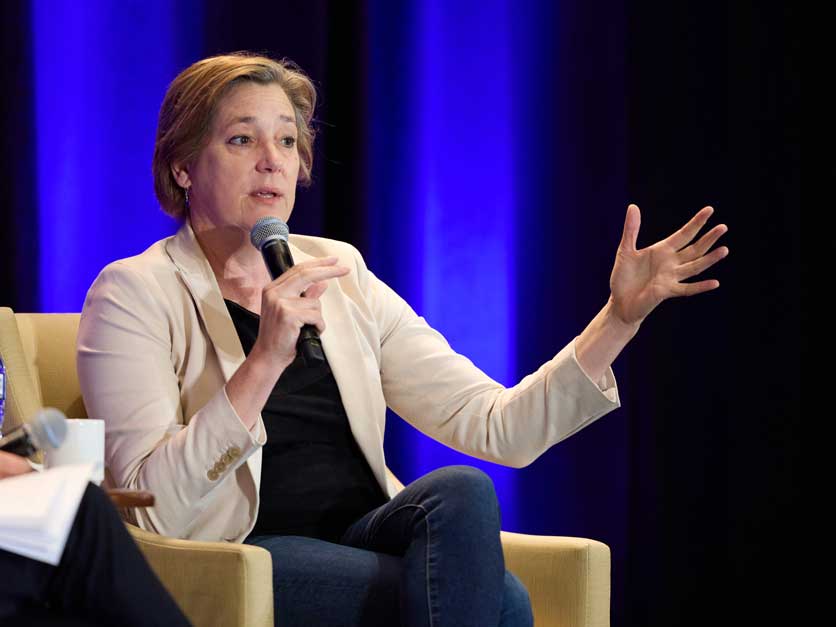As director of the Department of Water Resources, Karla Nemeth stands at the center of several monumental changes underway for California’s water supply. Nemeth shared her thoughts on what to watch this year during a discussion with Agri-Pulse at the annual Food & Ag Issues Summit on Monday.
“2023 has been a stunning year for California,” she began. “There’s really no other way to put it.”
The state experienced “horrible runoff conditions” in 2021 that plunged it into a challenging drought and highlighted the work needed to better plan for such climate extremes. DWR and other agencies faced difficult decisions in 2022, particularly with an unprecedented level of fallowing in the Sacramento Valley. Then intense storm events rebuilt the entire water supply in just a few months this year. To Nemeth, the past three years have demonstrated opportunities to “reimagine our infrastructure” to be more efficient. That means more water recycling and conservation in urban areas and harnessing flood flows for groundwater recharge in agricultural regions.
DWR estimates the state could percolate as much as 3.3 million acre-feet of water underground from the vast snowpack this year. Nemeth acknowledged it is difficult to measure and track how much the state is recharging, but it is likely about half the available capacity. She stressed that while 1.8 million acre-feet is still good, enormous opportunity exists to improve on that. She hopes the push for recharge will drive infrastructure improvements and deliver some valuable learning lessons for “roll-up-your-sleeves management changes that need to happen,” particularly with forecasting incoming storms to inform reservoir operations.
The first test of that balancing feat will come this fall. The state is entering potentially dry El Niño conditions with nearly all major reservoirs now at full capacity. Ahead of the next winter storms, DWR and its federal counterpart, the Bureau of Reclamation, must evacuate those reservoirs to create space and transitions the state to flood control. The agencies are carefully considering the options available for putting that water to beneficial use.
 DWR Director Karla Nemeth
DWR Director Karla Nemeth“The hydrology is demonstrating some enormous opportunities for California if we can rise to the occasion,” she said.
Nemeth also pressed the need for more flexible regulatory mechanisms to allow the state to pump more water from the Sacramento-San Joaquin Delta when a massive amount of water is flowing through it. In January, strict regulations for endangered species protections led the state to lose out on more than 200,000 acre-feet of water. The administration’s proposal for a tunnel, known as the Delta Conveyance Project, could have moved that water with no harm to the fish, she said.
“We didn’t know how the rest of this water year was going to shake out. We saw that very dry period in February,” she said. “We’ve got to think about those investments and get that work done.”
To plan for the next drought, she referred to a slew of new policy actions making it easier for farmers to divert flood flows for groundwater recharge. DWR has also gained funding from the Legislature to examine the potential climate risks for all major watersheds that have headwaters in the Sierra Nevada mountains and feed into the Central Valley. In collaboration with groundwater sustainability agencies (GSAs), that research will inform infrastructure decisions and enable the valley to recharge groundwater at a much larger scale.
“We need to be in a position to keep all that water out of the lakebed and get it underground. We can do better,” she said. “This is a year that's demonstrating orders of magnitude around infrastructure investment that can help that happen.”
She saluted recent progress with water storage funding, particularly with the State Water Resources Control Board advancing the water permit application for the proposed Sites Reservoir. But she described the Proposition 1 water bond program at the California Water Commission as “extraordinarily cumbersome” as well as complicated to implement and impossible to change without a vote on a public ballot. The administration is considering a climate resilience bond and she hopes that will provide an opportunity for revising the language to streamline the program.
“It’s not good to be nine years on and still working hard to get those projects over the finish line,” she said, noting that adding more storage would benefit fish species as well. “We have to have the stomach to look at our existing infrastructure and adjust it and reinvest to help it work better.”
DWR has taken on a significant new workload in recent years from reviewing local plans under the Sustainable Groundwater Management Act (SGMA). The department deemed six of those plans inadequate in March, sending them to the water board to act as the regulatory backstop for SGMA. The biggest challenge for those GSAs, explained Nemeth, is the fractured governance, which is driven by local politics.
“It's not a good sign,” she said. “We really need these GSAs to be doing the opposite and actually coming together.”
She is striving to find ways to induce greater regional coordination and a more equitable approach to the available water.
“My fear is that the GSAs that aren't getting it together are going to miss the boat—to the detriment of their communities,” she said. “It is a crucial moment in groundwater management, particularly in the valley.”
At the southern end of the state, Nemeth sees the need for more infrastructure investments to bolster California’s new agreement with the other lower basin states along the Colorado River. She called for more recycling and aggressive conservation in urban areas, such as removing nonfunctional turf, while also adjusting agriculture to better match the future hydrology of the region. She cheered Arizona Governor Katie Hobbs for limiting urban expansion in Phoenix since the water supply would not support it.
“There's just not a lot of breathing room for sacred cows anymore,” she said. “The problem is so intense that everyone has to come to the table with a solution.”
For more news, go to Agri-Pulse.com.


